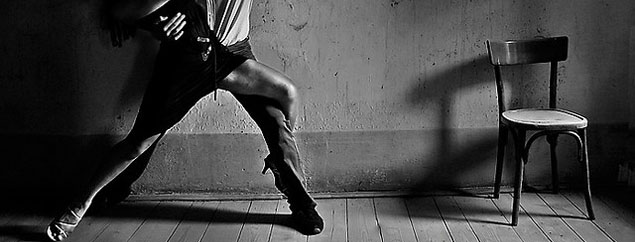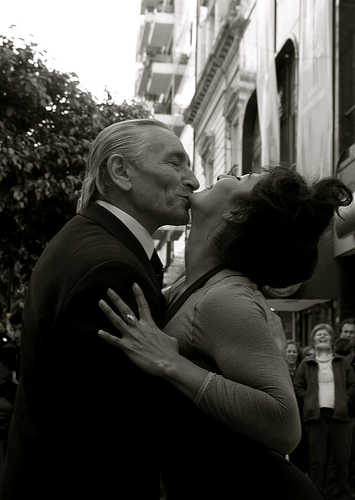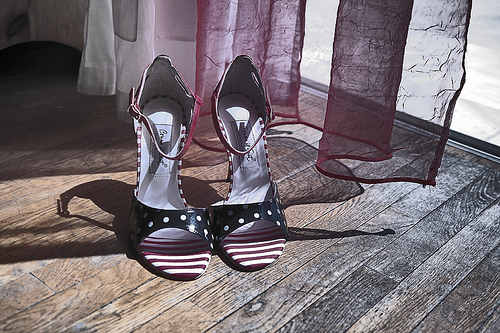
Basics of Tango (Part One)
23 May, 2011Ah… Tango! No doubt, the most idealised paired dance in the world. And there’s plenty of reasons for that. The closeness, the intimacy, the cadence, the wordless conversation of the bodies, the acute polarisation of the gender’s roles… All of that and so much more makes tango an extremely rich field of exploration for the brave souls that dare step into it. Because, true enough, it takes time and dedication to harvest the fruits of its practice, but when it arrives their sweetness is such, it can become quite addictive indeed.
Here’s an overall description of what tango dance is about, in case you can’t make any sense of what’s going on inside the head of those couples that are usually seen performing impossible synchronised moves while looking totally cool and undisturbed. We’re also letting our militant side show by adding a few good reasons for you to bite into it and maybe consider giving this mythical dance a good go, plus some preparation tips. Lo and behold!
Basic Description
In tango dance, two roles need to be covered: leader (usually male) and follower (usually female). The leader is in charge of improvising the dance on the go, based on an eight-step template that works as a foundation, plus an infinitude of ‘figures’ that stem from it and can be combined, mixed and matched, and repeated at will. Also, and as important, there’s certain ‘signals’ to be performed by the leader, which are subtle and precise body-language commands that let the follower know in advance what’s the step sequence or figure that’s coming up next, so they will both perform it in sync. The follower’s role is all about surrendering to the leader’s guide and performing what has been signalled, with regular chances to freely adorn the thing here and there. So even though there’s a thorough and equal amount of learning of the steps and sequences and signals that needs to take place for both roles, the follower is by far a lot less work and responsibility than the leading role when it comes to the actual dancing, and that’s one of the main reasons why women always outnumber men within the Tango scene.
History
The history of Tango dance is no less complex than the practice of it. Full of twists and turns, ups and downs, and many fabulous characters throughout, it amply exceeds the coverage of this article. If you’re interested in dipping your toes in it, we suggest you visit www.history-of-tango.com.
Overall Benefits of The Practice:
For Men:
Plenty of girls to choose from
Yes, you could say: “how shallow”, but really… men that are smart, graceful, courageous and persevering enough to nail tango and make it all the way to a milonga dance-floor are quite rare. So if you do manage to get there, you are already a winner and chances are that your social and love-life will take a big step forward. Also, don’t be surprised if you find some high-level competition too.
Chance to lead

There might not exist any other field in our current western society where you can make women do what you want without even having to open your mouth, besides a milonga dance-floor. So in that regard, it definitely is a unique experience.
Brain workout
No doubt your IQ increases significantly after having mastered the art of tangoing. If you can improvise in your head the creation of a puzzle-dance and resolve it with your body on tempo with the music, while letting your partner know your next move exactly a quarter of a second before you go there AND perform it gracefully in sync with her, you might as well be able to come up with the next Big-Bang theory.
For Women:
Shape your legs
And not only that. The practice of tango allows you to find your centre, your balance, root yourself to earth, own and distribute your weight at will, stand straighter and taller. Develop gracefulness and sensuality for the same price, or your money back.
Learn to surrender
Priceless skill to have (even vital for women) in both the spiritual and the love-life fields. Especially in an era where women are dashing through their lives by the auto-pilot use of an inherited masculine, dominant and overachieving attitude. So there.
Chance to experience supreme romantic moments
Why deny it? Buttering the dance-floor with your tired, tipsy feet to a good old mellow Piazzolla tune in the wee hours of the night; sweaty cheek to sweaty cheek with your lover, eyes closed and completely surrendered, your head long-burnt in the dizzy bonfire of passion, is quite surely as sensual and delicious as it gets (in a public space). Might take you a couple of years to get there… but my, it’s worth it!
Getting Started
Foot Care

No good shoes, no tango. It’s that basic. And even though comfort is a must –you’ll be spending many, many hours a week in those once you start practising seriously- there’s no use in travelling to Buenos Aires to get some fit-like-a-glove custom-made tango-shoes while you’re still a beginner. So what should you look for? Well, both men and women need to be able to pivot freely on their metatarsus, so rubber is out of the question. Old-fashioned leather soles are always the best thing to go with, but you might find newer materials that allow you to spin just as well, so go ahead and explore the different dynamics. Dancers must keep their toes covered at all times (please never wear sandals for tango, unless you’re up for a ‘Big Lebowski’ kind of scene). Heels are different for men and women. Men need to pivot on their heels too, so again rubber wouldn’t work. But women need to be able to stop themselves from sliding, so a rubber-tipped heel is highly recommended. Women’s heels should be between 7 and 10cm long, and must have that classical and stylish curve towards the inside. Straight heels will get you all tangled up so don’t even think about it. Also, don’t go over the top with your learning pair/s, you’ll soon find out how easily they get all scratched and stepped on. There is no way to avoid this. You’ll get your shoes ruined and you’ll be ruining everybody else’s too, just enjoy the mess!
The right teacher
You need to find a teacher that suits your needs and you can commit to attending regularly for a learning period of at least 6 months, once a week. There’s lots to be learned before you attend a milonga and even more to practice. Your teacher doesn’t need to be an acrobat (mine was actually 90 years-old and could barely walk, but would teach us everything we needed to know and with such patience and clarity!) but he/she must be down to earth. You don’t want a teacher that rushes you through your learning, making you do stuff you don’t even understand, while you still have your basics to master. And most important, they must be fun to work with! The beginning stages of learning tango can be very tedious and repetitive so if your teacher doesn’t know how to make it fun, you can find yourself feeling discouraged very, very soon. And that would be a real shame.
We recently launched a tango directory here at Sounds and Colours for anyone wishing to learn tango in London. So whether you’re looking for a class or you’re a tango school and want to be listed just click here
Follow Sounds and Colours: Facebook / Twitter / Instagram / Mixcloud / Soundcloud / Bandcamp
Subscribe to the Sounds and Colours Newsletter for regular updates, news and competitions bringing the best of Latin American culture direct to your Inbox.

